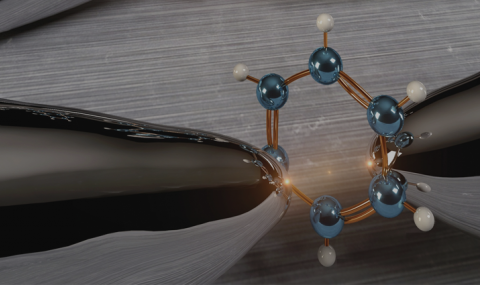Perhaps the most essential requirement for spin based electronics (spintronics) is the generation of highly spin-polarized currents governed by electrons of a single spin type. To date this challenge appeared to be far from reach at the nanoscale. Recently, we demonstrated the generation of up to 100% (with 2% uncertainty) spin-polarized current at the nanometer scale. The realization of complete spin filtering was achieved by orbital symmetry considerations in nickel-oxide (NiO) atomic chains (R. Vardimon et al. Nano Letters 15, 3894 (2015)).
Conductance and shot noise measurements revealed that the NiO junction has a fairly high conductance (~0.6e2/h) that is dominated by a single spin conduction channel. Interestingly, we found that it is enough to elongate a Ni atomic junction by ~2-3Å in the presence of oxygen to gain more than 98% spin-polarized conductance. This observation indicates that insertion of about one oxygen atom already leads to strong spin filtering. Once that high spin filtering is achieved the effect is preserved during the elongation of a NiO atomic chain, forming an efficient atomically-thin spin conductor.
In this work, interface chemistry was used to reach the upper limit of spin filtering and overcome the long-standing problem of limited spin injection from ferromagnetic metals. Specifically, we took advantage of the symmetry-based preference of oxygen p orbitals to hybridize with the spin-polarized d states around the Fermi energy of Ni electrodes rather than with the Ni s states. This selective hybridization promotes the injection of spin-polarized currents from the Ni d bands and suppresses the injection of spin-degenerate currents from the Ni s bands. The emergence of spin polarization was probed by shot noise measurements as was previously demonstrated for a variety of systems. Here, we expended this method to give a lower boundary for spin polarization (Fig. 6a, thin black lines) without any assumption about the number of conduction channels, and thanks to our numerical technique, we probed for the first time the behaviour of spin-polarized conductance channels. Our findings, in accordance with ab-initio calculations, indicate that the demonstrated spin-filtering is achieved by the emergence of atomic-scale half-metallicity at the junction. The scope and implications of these observations are now examined in my lab by magnetoresistance measurements in an atomic-scale spin-valve configuration.
The discovery of significant spin filtering at the nanoscale can promote the realization of a variety of novel nanoscale spintronic effects. In particular, highly spin-polarized current in atomic scale junctions is essential for the generation of spin-torque transfer at the atomic-scale, magnetic induced insulator to conductor transitions, and new types of magnetoresistance based on non-collinear magnetization.


